R1in136
SRR 14708237
General Information
- Sample Name
- ERM1
- Accession Date
- May 31, 2021
- Reported Plant Sex
- not reported
- Report Type
- Whole-Genome Sequencing
The strain rarity visualization shows how distant the strain is from the other cultivars in the Kannapedia database. The y-axis represents genetic distance, getting farther as you go up. The width of the visualization at any position along the y-axis shows how many strains there are in the database at that genetic distance. So, a common strain will have a more bottom-heavy shape, while uncommon and rare cultivars will have a visualization that is generally shifted towards the top.
Chemical Information
Cannabinoid and terpenoid information provided by the grower.
Cannabinoids
No information provided.
Terpenoids
No information provided.
Genetic Information
- Plant Type
- Type III
File Downloads
The bell curve in the heterozygosity visualization shows the distribution of heterozygosity levels for cannabis cultivars in the Kannapedia database. The green line shows where this particular strain fits within the distribution. Heterozygosity is associated with heterosis (aka hybrid vigor) but also leads to the production of more variable offspring. When plants have two genetically different parents, heterozygosity levels will be higher than if it has been inbred or backcrossed repeatedly.
The ratio of reads mapped to Y-contigs to reads mapped to the whole Cannabis genome (Y-ratios) has been demonstrated to be strongly correlated with plant sex typing. This plot shows the distribution of Y-ratios for all samples in our database which were sequenced with the same method (panel or WGS) as this sample and where this sample falls in the distribution.
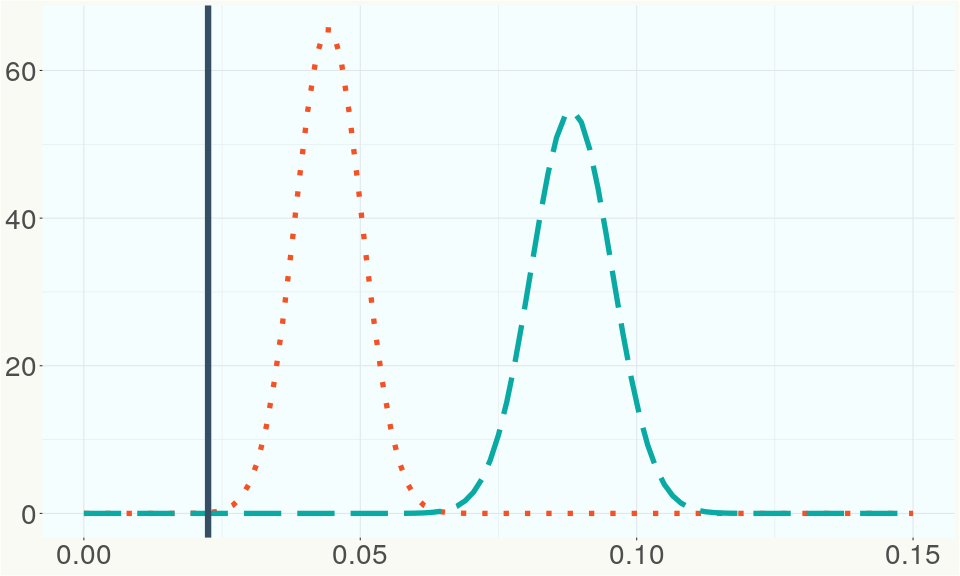
This chart represents the Illumina sequence coverage over the Bt/Bd allele. These are the three regions in the cannabis genome that impact THCA, CBDA, CBGA production. Coverage over the Active CBDAS gene is highly correlated with Type II and Type III plants as described by Etienne de Meijer. Coverage over the THCA gene is highly correlated with Type I and Type II plants but is anti-correlated with Type III plants. Type I plants require coverage over the inactive CBDA loci and no coverage over the Active CBDA gene. Lack of coverage over the Active CBDA and Active THCA allele are presumed to be Type IV plants (CBGA dominant). While deletions of entire THCAS and CBDAS genes are the most common Bt:Bd alleles observed, it is possible to have plants with these genes where functional expression of the enzyme is disrupted by deactivating point mutations (Kojoma et al. 2006).
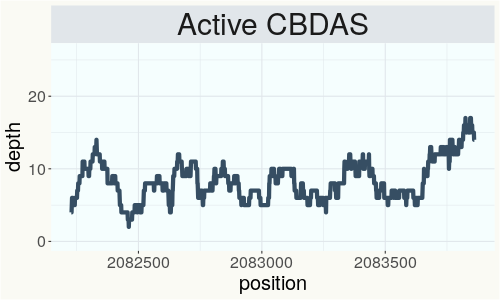
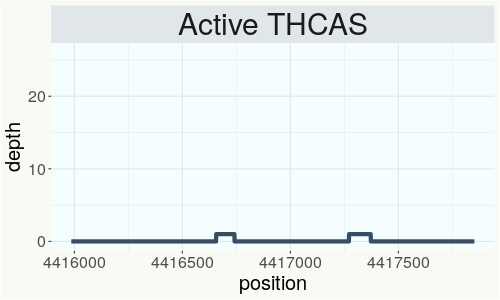
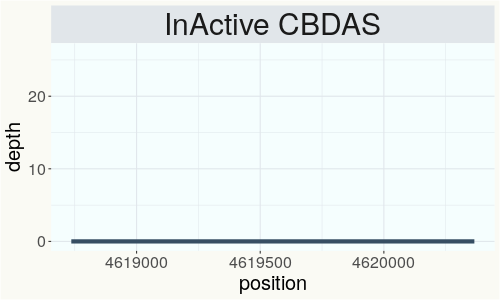
This chart represents the Illumina sequence coverage over the CBCA synthase gene.
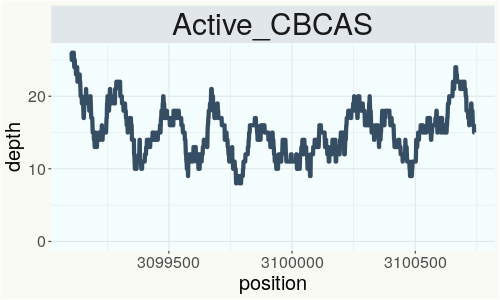
Variants (THCAS, CBDAS, and CBCAS)
Variants (Select Genes of Interest)
| GPPs1 | c.896A>G | p.Asn299Ser | missense variant | moderate | contig676 | 169772 | A/G |
|
| PHL-2 | c.2783G>A | p.Ser928Asn | missense variant | moderate | contig2621 | 342826 | G/A | |
| AAE1-1 | c.1427T>C | p.Ile476Thr | missense variant | moderate | contig606 | 3242844 | A/G |
|
| DXR-2 | c.1319T>C | p.Ile440Thr | missense variant | moderate | contig380 | 285250 | A/G |
|
| aPT1 | c.406A>G | p.Ile136Val | missense variant | moderate | contig121 | 2839605 | A/G | |
| AAE1-2 | c.331A>G | p.Asn111Asp | missense variant | moderate | contig81 | 209293 | A/G |
|
| AAE1-2 | c.1006A>G | p.Lys336Glu | missense variant | moderate | contig81 | 209968 | A/G |
|
| AAE1-2 | c.1415G>A | p.Ser472Asn | missense variant | moderate | contig81 | 210377 | G/A |
|
| AAE1-2 | c.1417A>G | p.Thr473Ala | missense variant | moderate | contig81 | 210379 | A/G |
|
| AAE1-2 | c.1434G>T | p.Glu478Asp | missense variant | moderate | contig81 | 210396 | G/T |
|
| TFL1 | c.304G>A | p.Asp102Asn | missense variant & splice region variant | moderate | contig1636 | 520613 | C/T |
|
| TFL1 | c.302-1G>A | splice acceptor variant & intron variant | high | contig1636 | 520616 | C/T | ||
| EMF2 | c.722C>T | p.Thr241Ile | missense variant | moderate | contig954 | 3050302 | C/T | |
| EMF2 | c.1315G>C | p.Ala439Pro | missense variant | moderate | contig954 | 3055804 | G/C | |
| EMF2 | c.1772A>G | p.Gln591Arg | missense variant | moderate | contig954 | 3059929 | A/G | |
| aPT4 | c.153A>C | p.Lys51Asn | missense variant | moderate | contig121 | 2828809 | A/C |
|
| aPT4 | c.198A>C | p.Lys66Asn | missense variant | moderate | contig121 | 2828854 | A/C |
|
| aPT4 |
c.235_236del |
p.Val79fs | frameshift variant | high | contig121 | 2829030 | ATG/A |
|
| aPT4 | c.238delT | p.Ser80fs | frameshift variant | high | contig121 | 2829034 | AT/A |
|
| FLD | c.2686G>A | p.Ala896Thr | missense variant | moderate | contig1450 | 2044848 | C/T | |
| FLD | c.2681T>C | p.Ile894Thr | missense variant | moderate | contig1450 | 2044853 | A/G | |
| AAE1-3 | c.635G>A | p.Gly212Asp | missense variant | moderate | contig976 | 1083219 | C/T |
|
| AAE1-3 | c.634G>C | p.Gly212Arg | missense variant | moderate | contig976 | 1083220 | C/G |
|
Nearest genetic relatives (All Samples)
- 0.132 R1in136 (SRR14708227)
- 0.138 Juso14 (SRR14708259)
- 0.169 R1in136 (SRR14708226)
- 0.171 USO31 (RSP10233)
- 0.176 Santhica 27 (RSP10665)
- 0.181 Santhica27 (RSP10056)
- 0.187 R1in136 (SRR14708225)
- 0.194 Beniko (SRR14708275)
- 0.194 Tygra (RSP10667)
- 0.195 USO 31 (RSP10983)
- 0.196 Fedora 17 (SRR14708222)
- 0.197 Bialobrzeskie (SRR14708244)
- 0.201 VIR 223 - Bernburgskaya Odnodomnaya - bm (SRR14708217)
- 0.206 Santhica27 (RSP11047)
- 0.207 Ferimon 12 (SRR14708233)
- 0.208 USO 31 (RSP10981)
- 0.208 Lovrin (RSP10658)
- 0.210 Fedora 17 (RSP10661)
- 0.210 Delta-llosa (SRR14708272)
- 0.214 Fedora 17 (RSP11203)
Most genetically distant strains (All Samples)
- 0.470 Cherry Blossom (RSP11301)
- 0.469 Cherry Blossom (RSP11300)
- 0.460 Cherry Blossom (RSP11318)
- 0.455 Cherry Blossom (RSP11312)
- 0.448 Chematonic -Cannatonic x Chemdawg- (RSP11394)
- 0.448 Cherry Blossom (RSP11311)
- 0.443 Cherry Blossom (RSP11322)
- 0.442 Unknown--Cherry Wine---001- (RSP11268)
- 0.442 QQD2 (RSP11450)
- 0.440 Cherry Blossom (RSP11325)
- 0.439 Cherry Blossom (RSP11328)
- 0.437 Cherry Blossom (RSP11323)
- 0.437 Cherry Blossom (RSP11331)
- 0.436 Cherry Blossom (RSP11319)
- 0.436 Cherry Blossom (RSP11332)
- 0.436 Cherry Blossom (RSP11298)
- 0.434 QLE1 (RSP11451)
- 0.433 Cherry Blossom (RSP11306)
- 0.431 JL x NSPM1 4 (RSP11482)
- 0.431 Chem 91 (RSP11185)
Nearest genetic relative in Phylos dataset
- Overlapping SNPs:
- 6
- Concordance:
- 6
Nearest genetic relative in Lynch dataset
- Overlapping SNPs:
- 2
- Concordance:
- 2